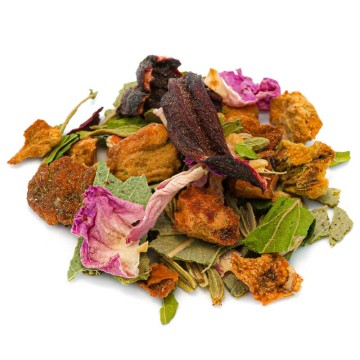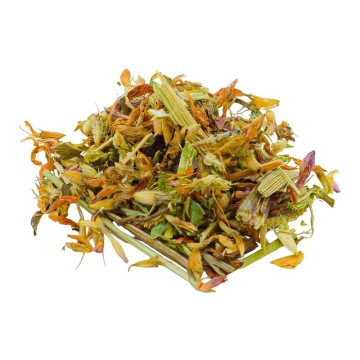This blend of aromatic herbs releases the many balsamic notes of eucalyptus, pine, and wild thyme, which are enhanced by the intense aromas of sage, rosemary, and mint. Its intense flavor and aroma deepen with the herbaceous notes of hyssop and southernwood, while the flavor is lightened by the delicacy of blueberry leaves and sweet-scented fennel. Lavender and mullein flowers add a relaxing floral note to the finish. Sip on cold days to experience moments of tranquility, breathing deeply in a soothing atmosphere.
Plants and Flowers
The herbal tea's ingredients are varied, derived from medicinal herbs or shrubs known for their natural properties, traditionally used for infusions and infusions. Although they originate from different regions, most of the plants are widespread in Europe – except for the Australian Eucalyptus – which is available dried and ready for infusion.
Eucalyptus, the botanical name for eucalyptus, is an evergreen shrub native to the temperate zones of Australia. It belongs to the Myrtaceae family and grows over 10 meters tall. It has smooth bark, long stems, and circular leaves.
Hyssop, or Hyssopus officinalis, is a perennial plant of the Lamiaceae family. Many varieties are known, used for medicinal and culinary purposes. It reaches up to 2 meters in height, has a slender stem, and produces highly fragrant purple-blue flowers.
Southernwood, or Artemisia abrotanum, is a perennial plant of the Compositae family, native to southern Europe. It grows in uncultivated land, reaching a height of about 1 meter. It has a cedar-like scent and was prized in herbal medicine by the ancient Greeks and in the Middle Ages.
Thymus serpyllum, commonly known as wild thyme, is a flowering plant in the Lamiaceae family. Native to Europe and North Africa, it has now spread to many regions. It is a low shrub, growing with creeping stems up to 10 cm long. The oval leaves are evergreen, and the scented flowers are lilac, pink-purple, or magenta.
Fennel, with the botanical name Foeniculum vulgare, is a flowering plant in the Apiaceae (Umbelliferae) family. Native to the Mediterranean region, it has spread to many parts of the world for its nutritional value. It grows well in arid soils, near the sea, and on riverbanks.
Juniper (Juniperus communis) is an evergreen conifer, a small tree, or shrub in the Cupressaceae family. It provides the main ingredient for gin and various herbal treatments. It grows in different varieties, preferring the cold climates of the Northern Hemisphere.
Licorice, with the botanical name Glycyrrhiza glabra, is a perennial plant in the Fabaceae family. It produces small, purple to light blue flowers and has long taproots that reach over a meter. These roots provide the ingredient with the typical flavor known as licorice.
Mint, or Mentha, is a perennial plant in the Lamiaceae family. It is widespread in many species, from 13 to 24, all with similar phytotherapeutic properties. Many renowned hybrids and varieties of mint are used primarily for food.
Pinus sylvestris, Scots pine, is a species of tree in the Pinaceae family. Native to Eurasia, it grows both at sea level and as a mountain tree up to over 2,000 meters. It features short, blue-green leaves and reddish-orange bark.
Mullein or Verbascum thapsus is a species in the Scrophulariaceae family. This biennial plant can grow up to 2 meters tall, with small yellow flowers and a large rosette of leaves. It grows in various habitats, best in sunny soil.
Salvia officinalis is a plant in the Lamiaceae family, in the Mentheae subfamily. It is native to the Middle East but has been widespread in our lands for millennia, thanks to its healing and nutritional properties. It grows up to 40-50 centimeters tall, with an extensive root system.
The rosemary plant is Salvia rosmarinus, a shrub in the Lamiaceae family. As a medicinal herb, it is also known for its leaves being used in cooking. It blooms from autumn to spring, with linear, highly aromatic leaves, green on top and whitish underneath.
Basil (Ocimum basilicum) is a culinary herb from the Lamiaceae family. It is native to the tropical regions of central Africa and southeast Asia, and is found in many varieties and hybrids. The type commonly used as a flavoring is sweet basil (or Genoese basil).
Oregano (Origanum) is a perennial herbaceous plant or shrub from the Lamiaceae family, cultivated for its aromatic and phytotherapeutic properties. It grows spontaneously in open or mountainous terrain and prefers sunny, arid soil.
The blueberry plant derives from shrubsDwarf evergreens of the Vaccinium genus and parts of the Oxycoccus subgenus—such as Vaccinium microcarpum or Oxycoccus microcarpus, Vaccinium oxycoccos or Oxycoccus palustris. They are widespread in North America, Chile, Europe, and northern Asia.
Lavender is a plant with many varieties, the most effective being "true" lavender, Lavandula angustifolia Miller, of the Lamiaceae family. Native to Europe, it is widespread in Italy as a small evergreen shrub. It features grayish-green leaves and flowers gathered in spikes. It adapts to many soils and latitudes, preferring sunny, not too windy areas.
How to use the herbal blend in herbal tea
The exact infusion is obtained by placing about 3-5 grams of the blend in a cup (250 ml) of water at 100°C.
Let the herbal tea steep for 8 to 10 minutes before drinking. Add honey or sugar, if desired.
The infusion can also be used for steam inhalations, according to natural aromatherapy practices.
Herbal Tea Mix: Side Effects and Contraindications
The ingredients are known in herbal tradition, and as with all herbal products, it is advisable to drink the herbal tea within the recommended doses. Excessive consumption may cause possible gastrointestinal side effects. Check the ingredient list of the herbal tea mix if you have known allergies or individual sensitivities to one or more ingredients. The herbal tea is not recommended during pregnancy and breastfeeding.









 No reward points for this product.
No reward points for this product.














